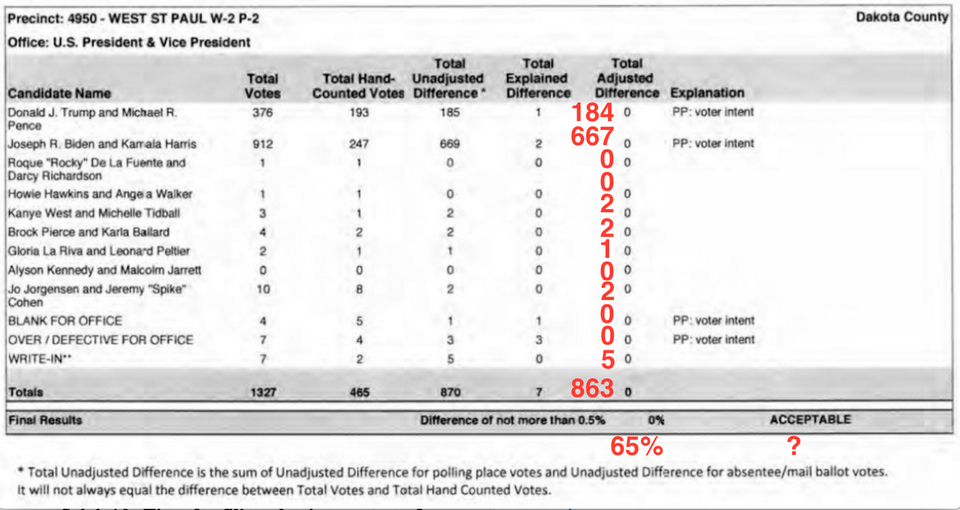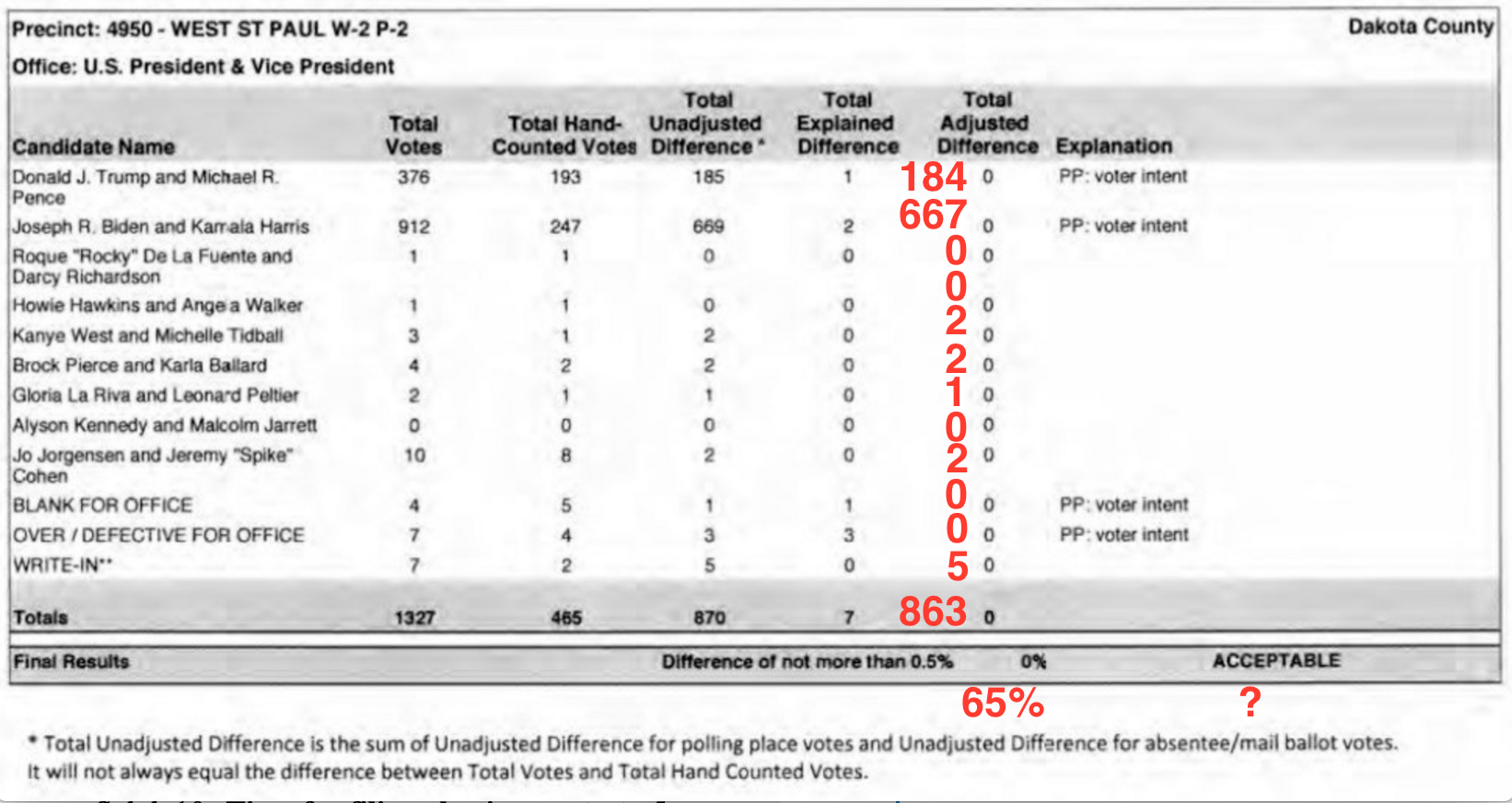South Saint Paul

Tomorrow in South Saint Paul at a workshop the Dakota Elections Manager, Michelle Blue, first on the agenda, will speak about how expensive hand counts are and perhaps some other jargon to dissuade the city from taking this very simple path—to reconcile the votes from voters with the results after the fact.
Our voting system can be thought of as a simple input-output system. It may seem obvious that what goes in should match what comes out. But for decades in Minnesota, the primary elections have not been audited and the general elections have only been checked when their are close races (recounts) or during the standard post election review (PER) hand counts governed by Minn Stat 206.89.
In fact, vote reconciliation (aka 'matching') doesn't have to occur between the "official" results and the MNSOS-overseen Statewide Voter Registration System (SVRS) until... wait for it... SIX (6) weeks after the election. This spacing (social distancing) allows the swirl of the reported election results to be distanced in voters' minds from the actual matter of what the tallies were.
Not to mention that this SIX (6) weeks is AFTER the certification of the county and state elections. Who is writing these election codes, who is passing them, and who is putting up with them? Do we have too many laws?
Vote reconciliation in 2020
In 2020, according to MNSOS data directly from the SVRS, there were more than seven hundred (700,000) absentee VOTES reported above and beyond what the SVRS contained as of November 29, 2024... 25 days after the election and already 5 days after the Minnesota State Canvassing Board had certified the election.
How was the Board able to certify the election if they had no tangible evidence—to look at for themselves or show to the public—to verify the machine-reported results?
This is also on top of the fact that there were SERIOUS issues with some of the post election review. Consider the Dakota County post election review where over eight hundred (800) absentee ballots were missing.

Trouble Continues in Dakota County
The fact that you may have never seen the above document is proof that it has been intentionally withheld from you. That's how censorship works. You never know what you're missing. History and art can be erased. Election results too.
I was in an unfortunately closed door meeting in early 2022 with the former Elections Manger of Dakota County, his deputy, and his boss, where he, hand shaking on the table, was unable to explain yet another discrepancy, this time of about 2,000 votes in the school district election of 2021 for ISD196.
Tomorrow, the new Elections Manager, Michelle Blue, will attend South Saint Paul's workshop just one week after a citizen laid out a plan which, if the city decided, would have their precincts included in the county's post election review.
If a municipality isn't chosen in the random drawing, then all voters in that area have no way of knowing whether their vote was counted individually or in aggregate. Cities and towns, which have outsourced their absentee and mail-in process, have no way of knowing if the county performed this task accurately. Deciding to be part of the post election review (the law does not prohibit more than 3% of precincts from being included) means that all ballots, those from face-to-face in-person voting on ELECTION DAY at the precinct, as well as those from ELECTION MONTH AND A HALF must be present to be counted.
In Precinct 4950, which was West St Paul (Dakota County), there were 800 ballots missing. How many other audits, if they'd been conducted, would have learned that indeed the seven hundred (700,000) ballots that were not (yet?) reconciled at the state level actually didn't exist at all?
What does a post election review cost?
About $1,000 per precinct. Sometimes less—it depends on how many voters you have in each precinct and how many down ballot races you choose to audit. Remember, usually down ballot races are NOT audited... so for example county commissioner is typically never audited.
They and I and many citizens have performed free consultations that many staff and representatives resisted. But not all. Some, like for instance Mayor West Rolf of Oak Grove (Anoka), where resolutions have been passed to join Anoka County's hand count audit as well as to remove unnecessary electronic iPads to check in voters (paper rosters must be available as emergency backup anyway and can be used) was one of those who took information from these consultants and stepped up.
Many have not. And will not. But there's still time.
The previous Dakota County Elections Manager resigned at some point, I believe in 2023. How long will the next one last? I do not know. It's my guess that the people will going forward prefer those that are actively trying to work with citizens and city councils instead of influence them under pressure.
Many have asked, Why is there so much resistance to hand counting? (After all, as confirmed by Gary at the Office of the Secretary of State, on the phone with a Dakota citizen Dan Wolbert, rule 8235 states that hand counting is the method of choice to be used in close races.)
What's Next
We hope that your city, town, and county will reconcile all reported votes with the Statewide Voter Registration system, for ALL ballots, prior to certification. This is a question that will be asked of every county canvassing board. So don't be surprised? And please have a good answer ready if you haven't... In my opinion, any county election that does not have fully and verifiably reconciled votes (between reported and what is shown in the Statewide Voter Registration System), is deserving of an official challenge.
We are currently pulling together a number of resources which will hopefully allow readers to see all of the above with their own eyes instead of having to wade through this writing.
We all have better things to do, like make informed decisions as city councils or town boards and help raise healthy families, instead of fighting over the minutiae of whether spending $1,000 to hand count one of your city's precincts is worth doing or not.
It's obviously worth doing, or the powers that be wouldn't be fighting it so damn hard.